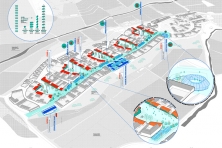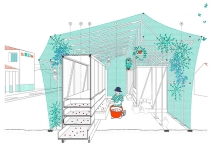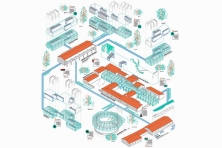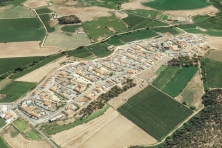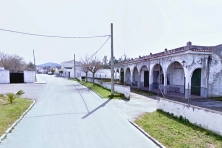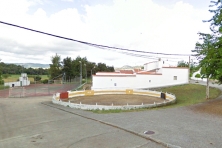La Buzzana
La Bazana (ES) - Mention Spéciale
DONNÉES DE L’ÉQUIPE
Représentant d’équipe : José de Andrés Moncayo (ES) – architecte
Associés: Ana Sabugo Sierra (ES), Alicia Peña Gómez (ES), Víctor Cano Ciborro (ES) - architectes
Collaborateurs: José Javier Cullen Afonso (ES), Sofía Lens Bell (ES) - architectes
Avenida Pío XII, 10-12, 1ºA 28016, Madrid (ES)
+33 629 715 787 – arquitecturasubalterna@gmail.com – arquitecturasubatlerna.com
Voir la liste complète des portraits ici
Voir la page du site en anglais ici

V. Cano Ciborro, A. Sabugo Sierra, J. de Andrés Moncayo, A. Peña Gómez , S. Lens Bell et J.J. Cullen Afonso
INTERVIEW en anglais
Cliquer sur les images pour les agrandir
1. How did you form the team for the competition?
The core of our team is formed by the collective Arquitectura Subalterna. We are a young Spanish collective that works in the context of the marginal groups inhabiting the urban peripheries. Around us, we have counted on the in-estimable help of close collaborators with whom we form work teams for each project.
2. How do you define the main issue of your project, and how did you answer on this session main topic: the place of productive activities within the city?
We propose the introduction of a new economic activity, the entomoculture, in the Spanish rural context as an engine capable of generating new economic, social and productive relations activating the rural environment and transforming its prospects for the future.
3. How did this issue and the questions raised by the site mutation meet?
The European rural environment is facing a serious crisis threatening the total disappearance of its productive ecosystem and the forms of life that it represents. The decline of agricultural activities offers the opportunity for transformations of abandoned infrastructure, for new purposes and productive activities.
4. Have you treated this issue previously? What were the reference projects that inspired yours?
Actually, this is the first time we have dealt with the subject. We are inspired by some theoretical projects of insects farming, and in the report of the FAO Edible Insects, which lays the foundations for the introduction of the production and consumption of insects.
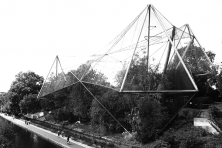
5. Urban-architectural projects like the ones in Europan can only be implemented together with the actors through a negotiated process and in time. How did you consider this issue in your project?
One of the key aspects of our proposal is to have the existent social agents on site to develop their own skills around new future activities. We propose a productive scheme capable of being implemented by successive phases deepening the social and economic repercussions of the proposed industry, understanding the implications in parallel sectors such as services, whose development runs in parallel the implementation of our Project.
6. Is it the first time you have been awarded a prize at Europan? How could this help you in your professional career?
Most of the team members have experienced Europan and some of the authors have been awarded in previous editions. We believe that this competition is an unmissable event for all those who want to give their critical vision of the urban and territorial future for the European continent, also being a form of debate and exchange of ideas is extremely useful and enriching.
